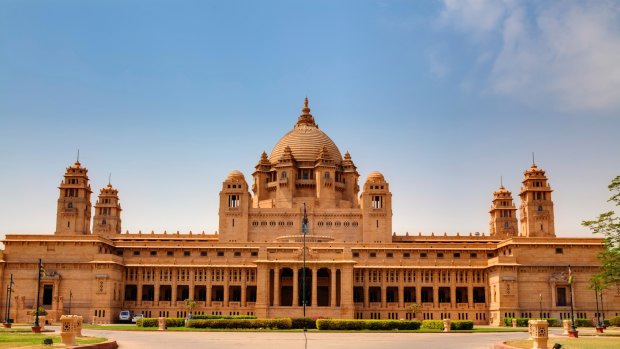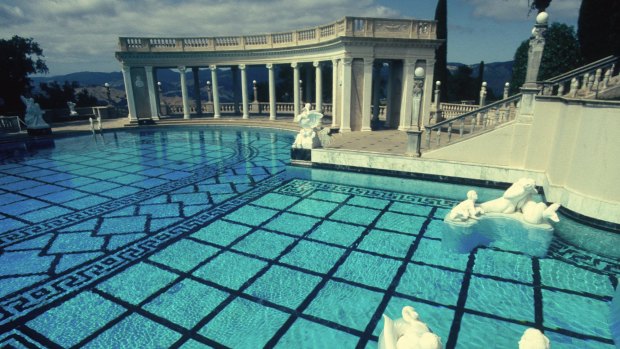This was published 8 years ago
Palaces you can stay in or visit: The top 10 former royal residences that are now open to the public
By John Borthwick
Bygone palaces, where maharajahs, shahs and dubious moguls once ruled, still survive across the world. Now monuments, hotels or heritage properties, these homes to the ghosts of panjandrums past have stories that are as fascinating as their stones.
BALTIT FORT, HUNZA, PAKISTAN
Pinnacles of forbidding stone and snow tower over the former palace-fortress of the Mir (king) of Hunza, which, in turn, towers over Karimabad, capital of this principality in the Karakoram Range. The 13th-century palace, now restored and open to visitors, is on the World Heritage tentative list. In 1889 Captain Francis Younghusband confronted the Mir, insisting he cease raiding the trade caravans from British India. Protesting that this was his traditional income, the Mir instead proposed that he give Queen Victoria a slice of the action. See baltitfort.org.

Umaid Bhawan palace hotel in the beautiful city of jodhpur in rajasthan state in indiaCredit: iStock
CASTLE LESLIE, COUNTY MONAGHAN, IRELAND
This 70-room castle, now an exclusive retreat, comes complete with a 400-hectare estate, church and memories of guests from Cromwell to Yeats and Churchill, as well as Paul McCartney's ill-fated 2002 wedding. Leslie family lore holds that Mick Jagger often hid out here in the 1960s. A bevy of visiting convent girls spotted him one day, chased him into the church tower and wouldn't free him until he'd signed their blouses or, better still, their bodies. Weeks later the castle received a distressed call from the convent Mother Superior, saying, "What am I to do? The girls still refuse to wash." See castleleslie.com.
UMAID BHAWAN PALACE, JODHPUR, RAJASTHAN, INDIA

The pool at Hearst Castle.Credit: John Borthwick
When the Maharajah of Jodhpur built this 347-room behemoth throughout the 1930s, it provided employment for thousands of people affected by famine. Today, part of it is one of the world's largest private residences (for the Maharajah's family) while another section is a Taj Group luxury hotel of 64 rooms and suites. The remainder, a family museum, is full of stuffed leopards, exotically customised Rolls-Royces, curious clocks and weapons. Its style might be Mughal-Edwardian Overkill (or more kindly, Late Raj meets Deco Taj) but, surmounted by a 30-metre Renaissance-style cupola and surrounded by vast gardens, this sandstone grandee is the last great palace of princely India. See tajhotels.com.
GREEN PALACE, TEHRAN
On the forested slopes above Tehran, the Green Palace was used by the last Shah, Mohammad Reza Pahlavi, for receptions and, allegedly, love trysts. Chandeliers drip like crystal stalactites and the rooms are tiled with thousands of mirrors. Perhaps this was meant to be a Persian Versailles for the Francophile shah. Instead, it's like being inside a giant cut-glass disco ball. Open to visitors. See persiatours.com.
HEARST CASTLE, SAN SIMEON, CALIFORNIA
What happens when a press baron wants the Round Table and Notre Dame in his lounge room? A sort of Gothic art salad in which, despite the improbable juxtapositions, every priceless tapestry, painting and 15th-century Spanish ceiling is exquisite. William Randolph Hearst's hilltop estate, La Cuesta Encantada (Enchanted Hill) is dominated by the 115-room Casa Grande where he previewed his newspapers each evening before printing. Some of the most famous names of the era, from Chaplin, Flynn and Gable to Churchill, Coolidge and Howard Hughes have been around his Graeco-Roman swimming pool. The 1941 Orson Welles movie, Citizen Kane, was seen as a thinly veiled portrait of Hearst, with its palatial Xanadu estate being this castle. www.hearstcastle.org
MALACANANG OF THE NORTH, PAOAY, LUZON
Philippines president Ferdinand Marcos built this substantial, though not grossly opulent, mansion overlooking Paoay Lake for his family and guests. After he was deposed in 1986, the family turned the two-storey building into a Marcos museum. This province, Ilocos Norte, has long been "Marcos country" but a court has ordered the clan to give up this large estate because Marcos commandeered public land for his private use. The museum is open to visitors. See visitpinas.com.
MARUEKATAYAWAN PALACE, PHETCHABURI, THAILAND
This vast wooden structure built as a summer palace in 1923 by King Rama VI of Siam stands on the beachfront north of Hua Hin. The "palace of love and hope" is billed as the longest golden teak palace in the world. Now superbly restored after decades of neglect, it is open to visitors. You can wander the elevated walkways, coming at last to the king's study (complete with mosquito net around the desk) that overlooks the sea. See thailand-huahin.com.
KRONBORG CASTLE, HELSINGOR, DENMARK
If graffiti were permitted, inevitably someone would scrawl "Hamlet was here", because this is the 15th century keep that Shakespeare immortalised as Elsinore in his play about the doomed prince of Denmark. Beyond this formidable pedigree, World Heritage-listed Kronborg is also one of Europe's most important Renaissance castles. It sits on the tip of Zealand Island, guarding the narrows between Denmark and Sweden. Actors including Olivier, Gielgud, Christopher Plummer and Derek Jacobi have portrayed the tragic prince in productions held here. See kronborg.dk.
NORBULINGKA PALACE, LHASA, TIBET
Lhasa's superstars are the Potala, the 1000-room former palace of the Dalai Lama, and the spellbinding Jokhang, Tibetan Buddhism's equivalent of St Peter's Cathedral. More down-to-earth is the Dalai Lama's summer palace, Norbulingka, which offers a poignant, time-warp experience. The 1950s mod cons of this pocket palace include an iron Shanks bathtub (carried by porters across the Himalayas from India) and a hi-fi gramophone. The Dalai Lama left it all behind when he escaped into exile in 1959 after the Chinese invasion. See www.travelchinaguide.com
THE ASTANA, KUCHING, SARAWAK
The home and castle of the fabled White Rajahs of Borneo (the only resident European dynasty to rule in Asia) sits on the north bank of the Sarawak River facing Kuching. The second Rajah, Sir Charles Brooke, built the Astana as a wedding gift for his Ranee. (Its name is a variation of "Istana", meaning palace.) After the third Rajah ceded his jungle kingdom to Britain in 1946, the elegant white building with towers and battlements became the residence of Sarawak's state governors, with the territory subsequently becoming part of Malaysia. See sarawaktourism.com.
Sign up for the Traveller Deals newsletter
Get exclusive travel deals delivered straight to your inbox. Sign up now.